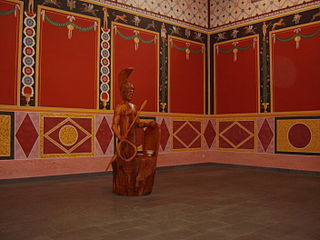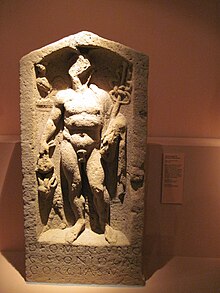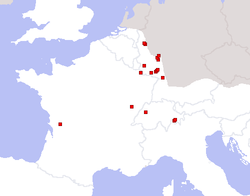
In Gallo-Roman religion, Rosmerta was a goddess of fertility and abundance, her attributes being those of plenty such as the cornucopia. Rosmerta is attested by statues and by inscriptions. In Gaul she was often depicted with the Roman god Mercury as her consort, but is sometimes found independently.
Artio is a Celtic bear goddess. Evidence of her worship has notably been found at Bern in Switzerland. Her name is derived from the Gaulish word for 'bear', artos.

In Gallo-Roman religion, Arvernus was the tribal god of the Arverni and an epithet of the Gaulish Mercury. Although the name refers to the Arverni, in whose territory Mercury had at important sanctuary at the Puy-de-Dôme in the Massif Central, all of the inscriptions to Mercury Arvernus are found farther away along the Rhenish frontier. The similar name Mercury Arvernorix, ‘king of the Arverni’, is also recorded once. Compare also the title Mercury Dumiatis, found in the territory of the Arverni. The name, like the name of the Arverni and of Auvergne, appears to derive from a Proto-Celtic compound adjective *φara-werno-s ‘in front of alders’.
In Gallo-Roman religion, Damona was a goddess worshipped in Gaul as the consort of Apollo Borvo and of Apollo Moritasgus.

In Gallo-Roman religion, Loucetios was a Gallic god known from the Rhine-Moselle region, where he was identified with the Roman Mars. Scholars have interpreted his name to mean ‘lightning’. Mars Loucetius was worshipped alongside the goddess Nemetona.

In Celtic mythology, Nantosuelta is the goddess of nature, the earth, fire and fertility.
In Gallo-Roman religion, Robor or Roboris was a god invoked alongside the genius loci on a single inscription found in Angoulême.

In Gallo-Roman religion, Smertrios or Smertrius was a god of war worshipped in Gaul and Noricum. In Roman times he was equated with Mars. His name contains the same root as that of the goddess Rosmerta and may mean "The Purveyor" or "The Provider", a title rather than a true name. Smertulitanus may be a variant name for the same god.

Vosegus was a name used in the Roman Empire for a Celtic god of hunting and forestation.
In Gallo-Roman religion, Buxenus was an epithet of the Gaulish Mars, known from a single inscription found in Velleron in the Vaucluse.

In Gallo-Roman religion, Sucellus or Sucellos was a god shown carrying a large mallet and an olla. Originally a Celtic god, his cult flourished not only among Gallo-Romans, but also to some extent among the neighbouring peoples of Raetia and Britain. He has been associated with agriculture and wine, particularly in the territory of the Aedui.
In ancient Celtic religion, Sulevia was a goddess worshipped in Gaul, Britain, and Galicia, very often in the plural forms Suleviae or (dative) Sule(v)is. Dedications to Sulevia(e) are attested in about forty inscriptions, distributed quite widely in the Celtic world, but with particular concentrations in Noricum, among the Helvetii, along the Rhine, and also in Rome. Jufer and Luginbühl distinguish the Suleviae from another group of plural Celtic goddesses, the Matres, and interpret the name Suleviae as meaning "those who govern well". The Suleviae have been identified in one inscription with the Junones, but mostly with the Matres, for example on an inscription from Roman Colchester, as well as on most of the inscriptions from Rome. The Colchester inscription reads:
Matunus or Matunos was a god in Brythonic Celtic polytheism. His name may be derived from the same root as Proto-Celtic *matu- meaning bear. He was worshipped in Roman Britain and altar-stones raised to him have been recovered in the United Kingdom, such as at High Rochester and at Risingham.

Gallo-Roman religion is a fusion of the traditional religious practices of the Gauls, who were originally Celtic speakers, and the Roman and Hellenistic religions introduced to the region under Roman Imperial rule. It was the result of selective acculturation.
Icovellauna was a Celtic goddess worshiped in Gaul. Her places of worship included an octagonal temple at Le Sablon in Metz, originally built over a spring, from which five inscriptions dedicated to her have been recovered, and Trier, where Icovellauna was honored in an inscription in the Altbachtal temple complex. Both of these places lie in the valley of the river Moselle of eastern Gaul in what are now Lorraine in France and Rhineland-Palatinate in Germany. One such inscription was, somewhat unusually, inscribed on a copper tablet in Roman cursive letters.

Visucius was a Gallo-Roman god, usually identified with Mercury. He was worshipped primarily in the east of Gaul, around Trier and on the Rhine; his name is recorded on about ten dedicatory inscriptions. One such inscription has also been found in Bordeaux. Visucius is, along with Gebrinius and Cissonius, among the most common indigenous epithets of the Gaulish Mercury.

Lenus was a Celtic healing god worshipped mainly in eastern Gaul, where he was almost always identified with the Roman god Mars.
Atepomarus in Celtic Gaul was a healing god. Mauvières (Indre), Apollo was associated with this god in the form Apollo Atepomarus.

Intarabus was a Gaulish god in the pantheon of the Treveri and some neighbouring peoples. His name is known from nine inscriptions from a relatively compact area in what are now Belgium, Luxembourg, western Germany and eastern France. He may have been the tutelary deity of one of the three pagi (subdivisions) of the Treveri. In most cases, Intarabus is invoked alone – without any synthesis to a Roman deity, and without accompanying female deities. However, one inscription invokes him as Mars Intarabus, noting that a fanum and simulacrum of this god had been restored at Trier. Meanwhile, another inscription from Mackwiller in Alsace gives Intarabus the epithet Narius. An inscription at Ernzen in Germany has his name as [In]tarabus, while another from Foy-Noville, invokes Entarabus in conjunction with the Genius Ollodagus.

Anvallus was a Gaulish god, known from several public inscriptions at Augustodunum (Autun). Two Latin inscriptions on altars were dedicated by gutuatres in requital of vows; both such dedications began with the formula Aug(usto) sacr(um). The title gutuater is typically understood to mean 'priest'; the gutuatres have at times been taken to be Romanized continuations of the druids. These altars were both discovered in 1900 on the site of Autun's railway station, along with a Greek-style helmet of thin bronze that would have been left there as a votive offering.















